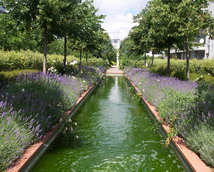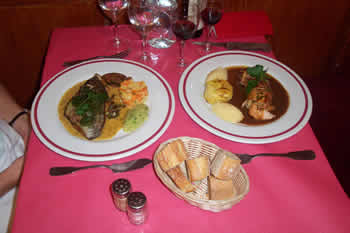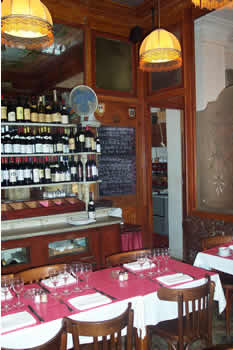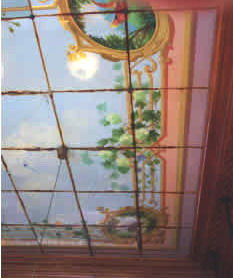A for Z
Les Zygomates
Paris, as I've remarked before, is an ideal city for walking. For those who enjoy both parks and  busy streets, the city fathers have thoughtfully converted a disused railway line, paralleling the avenue Daumesnil from the Bastille to the peripherique, into a landscaped Promenade Plantée, whose two-mile path lies between informal rows of bushes and small trees which open up at the bridges into architectural vistas of the streets below. There are frequent benches for the convenience of strollers, hobos, refugees from neighboring offices who bring their lunches, and small gangs of loitering boys who prefer a sylvan setting to a busy street corner. Underneath the arches is a progression of small shops and studios to which there is periodic access by stairways to street level.
busy streets, the city fathers have thoughtfully converted a disused railway line, paralleling the avenue Daumesnil from the Bastille to the peripherique, into a landscaped Promenade Plantée, whose two-mile path lies between informal rows of bushes and small trees which open up at the bridges into architectural vistas of the streets below. There are frequent benches for the convenience of strollers, hobos, refugees from neighboring offices who bring their lunches, and small gangs of loitering boys who prefer a sylvan setting to a busy street corner. Underneath the arches is a progression of small shops and studios to which there is periodic access by stairways to street level.
Having taken this walk with Frank and Barbara, I had no difficulty in persuading Mary to give it top priority for a return visit. As the ground rises the level railway line gradually descends from overhead to street level to a wide submerged cutting in which the vegetation has been allowed to grow higher and more densely, so that the path winds among the trees and sometimes divides into roughly parallel routes, giving it an ambience more rural than urban. It is a shock to come out of this mini-woods and find oneself close to the eastern edge of Paris's noisy peripherique.
Without making any precise plans we had aimed to finish the outward perambulation in time for lunch. Consulting my pocket Paris atlas, I discovered that I had once anticipated such a need by marking the location of a nearby bistro recommended by Patricia Wells. (If I had spent my life governing my spending as attentively as my dining, my estate would be as generously endowed as my anatomy.) Accordingly we set out in search of the quixotically named Les Zygomates. Arriving scarcely five minutes before last orders, we were soon to discover how fortunate we were.
In pursuit of the lazy reader, there is a fashion among Paris restaurants to give themselves names beginning with "a". (This is a modern trend - the index of the Time Out guide has only two columns of "a"s against three of "b"s and five of "c"s.) Diners of a contrary disposition will come first upon La Zyotissoire and then its parent bistro, Les Zygomates. The zygomatic muscles of the lower cheek are those which are essential for two of mankind's most pleasurable activities - smiling and chewing. This proved to be a bistro in which the two were inextricably related.
With a full meal ahead of us that evening we opted for a single main course. The blackboard's special offerings of the day included an irresistible crêpinette de faison farci au chou et foie gras at 100ff, which proved to be a roasted sausage-shaped bundle of sliced pheasant, with crispy skin on the outside, stuffed with cabbage and duck liver and surrounded with an intensely rich black sauce. Unusually for a French restaurant, it was accompanied not only by a cylinder of utterly delicious potatoes Anna, but also two scoops of buttery puréed celeriac. (I have eaten haute cuisine feasts in which the only trace of a vegetable was a decorative wisp of lettuce or parsley.)
 Mary was equally attracted to a filet de dorade au basilic at 95ff, sea bream crisply fried and surrounded with a rich green basil sauce. Her vegetable quotient was even more generous than mine - a "bubble and squeak" of chopped broccoli and puréed potato; finely diced carrot and potato in a cylinder held together with cream; and a scoop of stewed aubergine, tomato, onion and herbs. (Ours were among the most expensive main courses on an otherwise modestly-priced menu.) When we commented to our waitress on the generous and healthy variety of vegetables, she remarked that French children wouldn't eat all those greens. The international food industry seems to be doing its self-appointed task on a world scale.
Mary was equally attracted to a filet de dorade au basilic at 95ff, sea bream crisply fried and surrounded with a rich green basil sauce. Her vegetable quotient was even more generous than mine - a "bubble and squeak" of chopped broccoli and puréed potato; finely diced carrot and potato in a cylinder held together with cream; and a scoop of stewed aubergine, tomato, onion and herbs. (Ours were among the most expensive main courses on an otherwise modestly-priced menu.) When we commented to our waitress on the generous and healthy variety of vegetables, she remarked that French children wouldn't eat all those greens. The international food industry seems to be doing its self-appointed task on a world scale.
As usual, our luncheon vow to stick to one course evaporated when confronted with the alternatives. We compromised on one desert between us - a sampling plate at 50ff which  proved to be more than enough for two. An ample plate held a circle consisting of an exemplary thick rice pudding, an almond cake, a layered chocolate and cream cake, a chocolate tart in pâte brisée, a plum tart, and two slabs of chocolate goo (there's no better way to describe it). In the middle was a scoop of potently acidic orange sorbet which servedadmirably as a "mouth cleanser" between the rich little samples, and slotted into the sorbet were two angled sheets of chocolate, like the sails of the Good Ship Lollypop. We happily roamed the Seven Seas.
proved to be more than enough for two. An ample plate held a circle consisting of an exemplary thick rice pudding, an almond cake, a layered chocolate and cream cake, a chocolate tart in pâte brisée, a plum tart, and two slabs of chocolate goo (there's no better way to describe it). In the middle was a scoop of potently acidic orange sorbet which servedadmirably as a "mouth cleanser" between the rich little samples, and slotted into the sorbet were two angled sheets of chocolate, like the sails of the Good Ship Lollypop. We happily roamed the Seven Seas.
It was the end of the shift for our jolly waitress with well-exercised zygomatic muscles, and so she had time to tell us a bit about the bistro and its Paris offspring. The parent was seven years old and occupied what she told us had been a thirties-vintage buttery. Both Patricia Wells and Time Out say it was a butchers'. At any rate, the legacy is an unblemished interior of marble counters, painted etched glass, and polished walnut moldings surrounding mirrors, windows and doors. It all looks much older and more delicately ornate than the thirties. When we return (and we certainly shall), we'll try to find out more.
The chef, our waitress told us, is very fussy about detail. I can well believe it - this was a meal we would gladly have eaten at a Michelin-starred establishment. The locals, sadly, do not provide much custom. It's in the 12th, a not particularly well-off arrondissement, and so most of their regulars drive from other parts of Paris. (Fortunately, parking is easy.) Otherwise the bistro is dependent on those tourists who are prepared to make the considerable effort to come to an area which has little else of particular interest. There are usually a number of Americans who fall into that category, but after the September trauma they are thin on the ground. More than one waiter has recently told me that Paris restaurants of a certain class are having a very lean time. I hope that habitual American travellers will soon realize that they may well be safer in Paris than at home.
would gladly have eaten at a Michelin-starred establishment. The locals, sadly, do not provide much custom. It's in the 12th, a not particularly well-off arrondissement, and so most of their regulars drive from other parts of Paris. (Fortunately, parking is easy.) Otherwise the bistro is dependent on those tourists who are prepared to make the considerable effort to come to an area which has little else of particular interest. There are usually a number of Americans who fall into that category, but after the September trauma they are thin on the ground. More than one waiter has recently told me that Paris restaurants of a certain class are having a very lean time. I hope that habitual American travellers will soon realize that they may well be safer in Paris than at home.
Les Zygomates, 7 rue de Capri, 12th Arr., Tel: 01.40.19.3.40. M° Daumesnil
2006: It's still going strong. The luncheon menu is a mere 14€, the evening menus 22€ and 28€.Back to the beginning of this review
